Are you tired of scrolling through endless weight loss articles, getting confused about fat loss vs weight loss? Well, today we’re diving into the science behind these two concepts and shedding light on the myths surrounding them. Get ready to understand the difference between fat loss vs weight loss and unlock the secrets to a healthier, more vibrant you.
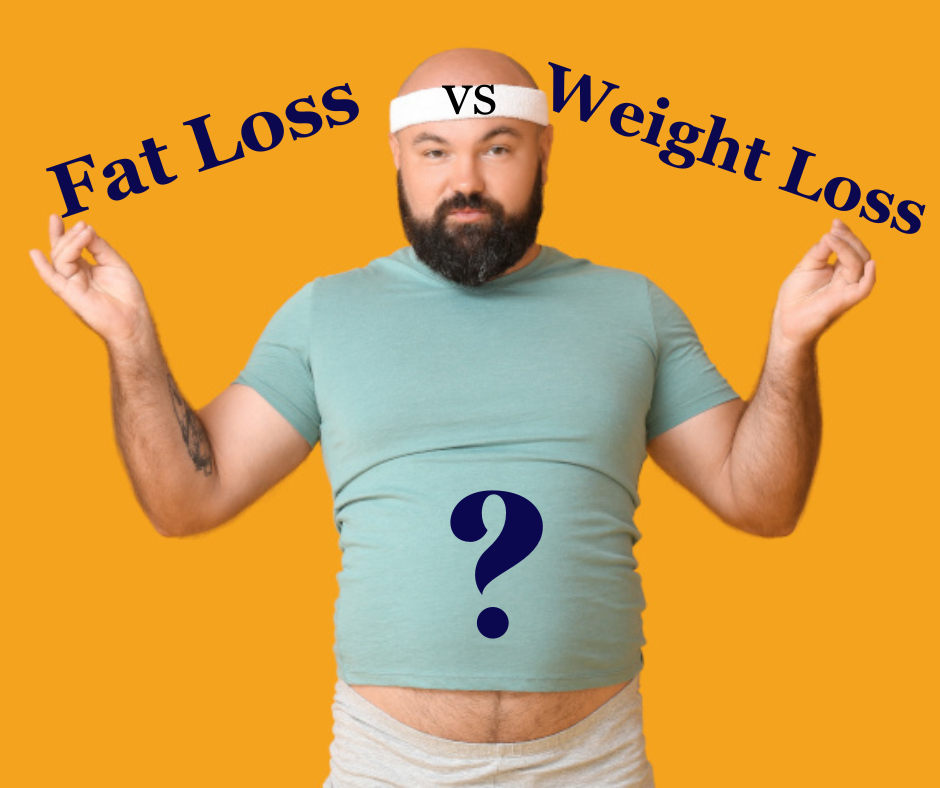
Firstly, before we get into the discussion of “fat loss vs weight loss“, lets clarify a very important aspect of this discussion and the principles involved in Fat Loss vs Weight Loss.
What is Fat: Decoding the Science Behind Weight Gain
At its core, fat is the body’s natural way of storing excess energy derived from the food we consume. When we consume more calories than our bodies need for immediate energy expenditure, the excess calories are converted into triglycerides – the building blocks of fat. These triglycerides are then stored within specialized cells called adipocytes, which make up our body fat.
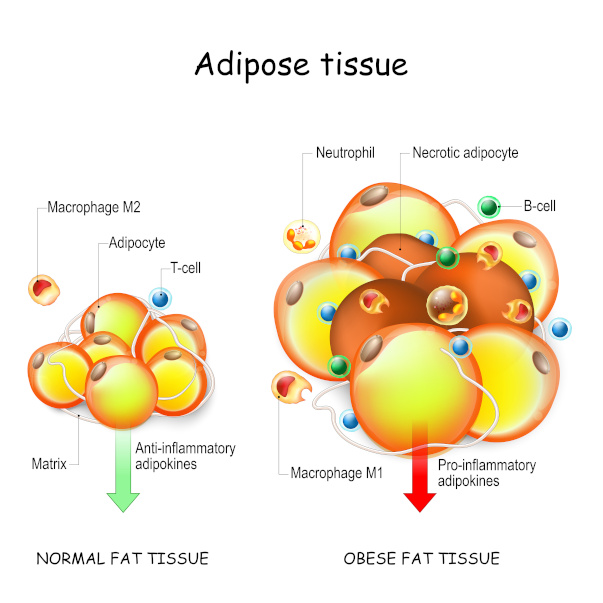
Fat Cell Clustering Causing Obese Fat Tissue
Adipocytes, often referred to as fat cells, cluster together to form adipose tissue – the tissue you can feel and pinch. As we consistently consume excess calories, these adipocytes (fat cells) expand to accommodate the accumulating triglycerides.
This expansion leads to weight gain and a gradual increase in body fat percentage.
Understanding the intricacies of fat accumulation empowers us to make informed choices about our diet and lifestyle. By adopting a balanced approach that aligns our calorie intake with our energy expenditure, we can maintain a healthier body composition and prevent the excess storage of fat. Remember, the key lies in striking the right balance between the energy we consume and the energy we burn through physical activity.
However, we need to be aware that there are 3 types of fat ; visceral, subcutaneous and brown fat. Subcutaneous fat is the fat deposited in the hypodermis layer under the collagen / elastin layers in the skin (see illustration -“Cell Structure” below.
Understanding Fat Loss: Delving into Adipocytes and Antioxidants
Losing fat is more than just a numbers game – it’s about understanding the intricate processes happening within your body. Enter adipocytes, the specialized cells that store fat. Fat loss occurs when these adipocytes release their stored fat, resulting in a leaner body composition.
But how does it happen? Let’s look under the surface of your skin to reveal the actual structure of our skin and the cellular structure that makes up our skin. Here you will understand how nutrition can improve not only health (and weight loss) but also improve our skin condition and take years off our looks. You will learn about collagen, elastin, hyaluronic acid and where your subcutaneous fat cells (adipocytes) are and effects of poor nutrition and good nutrition on these cellular structures.
Understanding the Cellular Structure of Skin, Collagen, Elastin, Hyaluronic Acid and the Fat Cells (Adipocytes)
Before we go into the workings of the fat cells (adipocytes), we need to understand where they are in our bodies and how they affect our appearance (weight gain, obesity and skin wrinkles).
In the diagram below we can clearly see the cellular structure of our skin with the outer layer (epidermis) at the top, the Dermis (central) containing the collagen fibres forming structure, the elastin to help keep skin tight and fresh while also controlling and reducing wrinkles, the hyaluronic acid and the fibroblasts.
Below this we can see the Hypodermis which contains the subcutaneous fat cells. It is this subcutaneous fat that gives rise to initial weight gain in endomorphs and (in the abdominal area) belly fat.
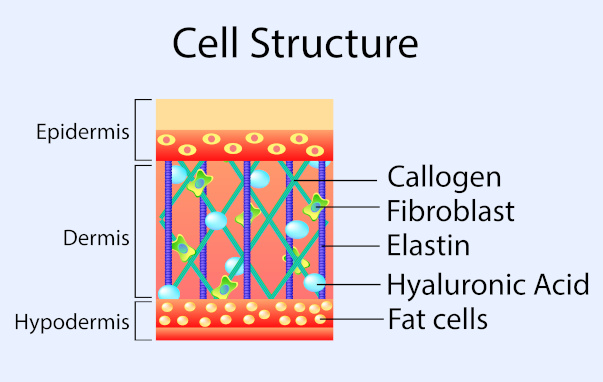
Collagen, Elastin and Hyaluronic Acid
Collagen / Callogen, Elastin and Hyaluronic acids are the main stay of healthy skin. You will no doubt have seen numerous commercials for skin products / topical creams to help in reducing wrinkles in the epidermis that provide collagen and hyaluronic acid.
Did you know, Collagen can be sourced naturally and at much lower costs than the aformentioned creams? Collagen is made up of proteins, which in turn are built from amino acids in your diet.
Simply improving your diet can improve the collagen, elastin and hyaluronic acid in your skin to make you look 10 years younger
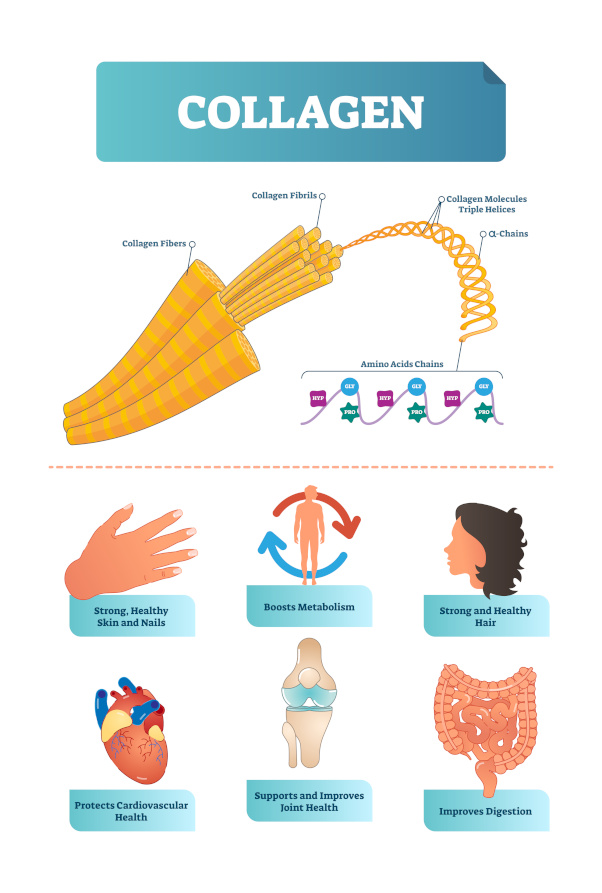
Collagen: Creation, Uses and Benefits
Collagen, a structural protein, derives its name from the Greek word “kólla,”
meaning glue, underscoring its role in maintaining tissue integrity. Formed through the synthesis of amino acids like glycine, proline, and hydroxyproline, collagen is a crucial component in skin, bones, tendons, and ligaments. Its molecular structure imparts strength and elasticity to connective tissues.
Beyond structural support, collagen plays a pivotal role in fortifying various bodily functions.
In terms of immunity, collagen aids in the production of antibodies, bolstering the body’s defense mechanisms. Cardiovascular health benefits from collagen’s contribution to arterial structure and elasticity, potentially reducing the risk of arterial stiffness.
Digestive health is enhanced as collagen supports the integrity of the gut lining, preventing permeability issues. Moreover, collagen is renowned for promoting healthy skin by maintaining moisture and suppleness, reducing wrinkles and promoting a youthful appearance.
Embracing collagen-rich foods (foods that contain a high volume of collagen creating nutrients like amino acids brings diverse health advantages, encapsulating a holistic approach to well-being.
How do Fat Cells Affect the Skin?
Uneven fat cell growth significantly influences skin appearance, contributing to phenomena like cellulite or “cauliflower skin” and wrinkles. As fat cells expand irregularly, they exert pressure on surrounding collagen and elastin tissues.
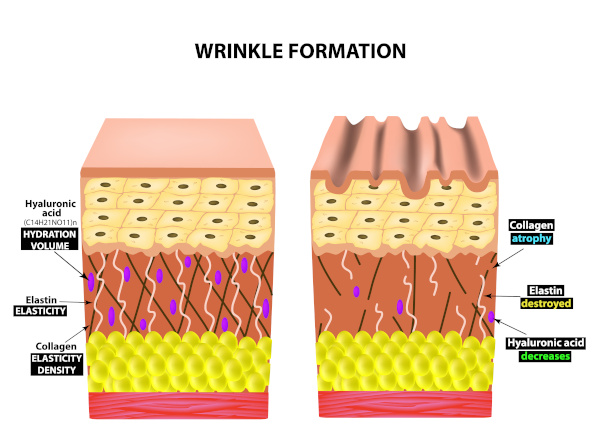
Wrinkle Formation and Cellulite
As fat cells expand irregularly, they exert pressure on surrounding collagen and elastin tissues
This uneven stretching creates a distorted surface, resembling the texture of cauliflower, and compromises the skin’s natural elasticity. Over time, repeated strain on these connective tissues leads to the formation of wrinkles.
Maintaining a balanced lifestyle that includes proper nutrition and exercise can help regulate fat cell growth, preserving the integrity of collagen and elastin for smoother, healthier skin and reducing the likelihood of the “cauliflower skin” effect.

A Healthy Physique with Taught Skin is a Primal Condition – Proof of Fitness to Mate!
While we have become more understanding and tolerant towards weight gain and unhealthy living with poor skin condition and looks – skin, physique and appearance are still important factors in human society deriving from our primal and ancestral lifestyle dating back to the caveman era.
Health and fitness are signs of good mating opportunities and successful reproduction of healthy genes in future generations forming part of our existing 12 reasons to lose weight.
Do not be fooled – cellulite is not sexist! It can (and will) form in both men and women!
The Fat Cell (Adipocyte): Understanding Fat Storage and Energy Release
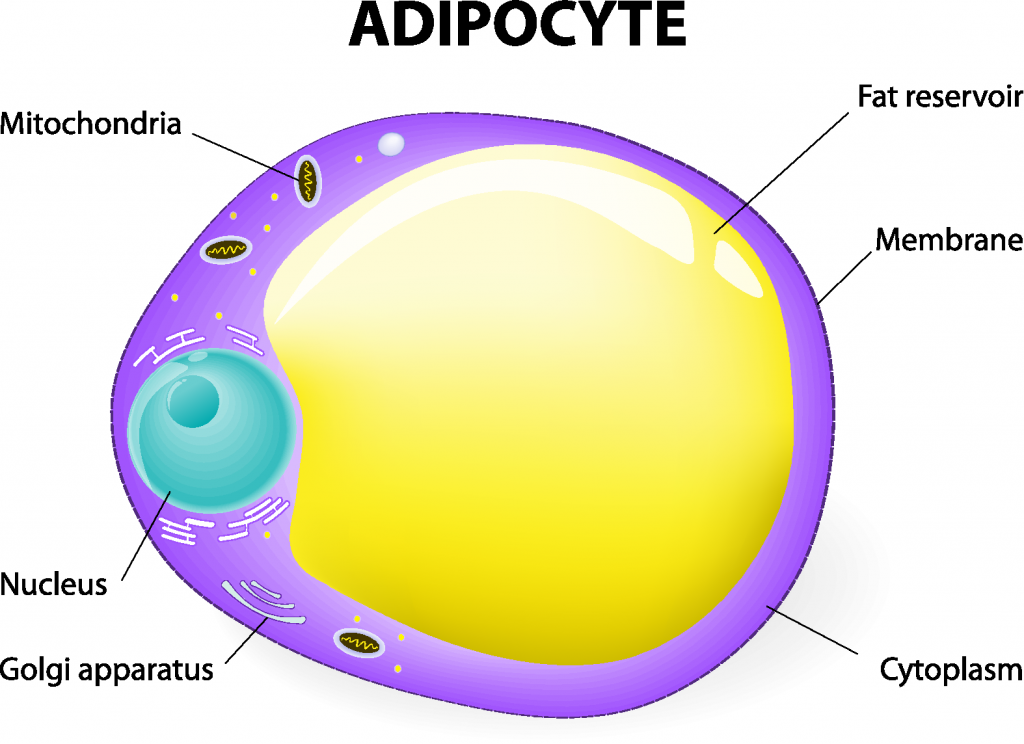
Imagine adipocytes as tiny storage units packed with fat molecules. When your body needs energy, it signals these cells to release the stored fat. This fat then enters the bloodstream and is transported to the muscles and organs within the body including the brain, where it’s burned for energy. Here’s where antioxidants come into play.
Antioxidants, those incredible compounds found in various foods like berries, green tea, and dark chocolate, are known for their cell-cleansing properties. When you consume antioxidants, they help cleanse the surface of the fat cell (the membrane) improving the efficiency of energy transfer into and out of the fat cell.
Antioxidants neutralize harmful free radicals that can damage cells, including adipocytes. By cleansing these cells, antioxidants make them more efficient in energy processes, contributing to effective fat loss.
Decoding Weight Loss: More Than Meets the Eye
Our individual weight is a sum of everything within our bodies – bones, muscle, brains, organs, skin, vitamins, minerals, water and fat. Weight loss (as opposed to fat loss), encompasses more than just shedding fat. It can include a combination of fat loss, muscle loss, bone loss, organ loss and water loss. Consequently, weight loss can include the loss of a body part.
“Weight Loss Can Include Organs and Limbs aswell as Fat“
Now, let’s address a fascinating aspect of weight loss. We can lose weight simply by losing a body part. While it’s true that amputating a limb or undergoing surgical removal of certain body parts will result in weight loss and a lower number on the scale, the implications are not as positive as they might seem.

Losing a limb, for instance, doesn’t equate to losing only fat. Muscle tissue and bone contribute significantly to your body weight. Moreover, such drastic measures can lead to psychological and physical challenges that overshadow any perceived benefits. The key is to focus on sustainable and healthy ways to achieve your weight and fat loss goals.
While many embark on crash diets and extreme measures in pursuit of rapid weight loss, the result might not be as favorable as expected. Losing muscle mass can lead to a slower metabolism and an overall weaker physique.
In Conclusion: Understanding Fat Loss vs. Weight Loss
In our goal of “losing weight” it is imperative we actually focus on losing fat. It is the excess fat that needs to be lost. So, when you settle on a suitable method for weight loss, ensure you are only losing the excess fat and remember the following in your journey.
Weight Loss encompasses the loss of mass from our bodies including Skin, Bone, Fat, Internal Organs, Muscle and Water
Fat Loss is Defined as a Loss of Fat from the Adipocyte ( Fat Cells) contained within our bodies under the skin and can be either subcutaneous fat (fat stored just below the skin or visceral fat (fat stored deep within the body and typically surrounds the internal organs restricting their purpose).
How do We Lose Fat?
How we lose fat is, then, a process of eating certain foods that reduce our excess energy intake and actively nourish and contribute to increasing our metabolism without causing the storage of excess fat. Subcutaneous fat (the fat in the hypodermis layer of skin) is relatively easy to lose compared to visceral fat which lies deep inside the body surrounding the internal organs. Brown fat is beneficial and actually helps us to burn more subcutaneous and visceral fat.
Consuming natural, raw foods that are rich in beneficial nutrients also helps cleanse our body of the toxins – toxins that are deposited in our body created through metabolism, ingestion from environmental factors (pesticides and other toxic chemicals, plastics from degraded packaging) digestion and the many other physiological processes.
In the grand battle of fat loss vs. weight loss, the true winner is a holistic approach that prioritizes your overall health and well-being. While fat loss targets those stubborn fat cells and utilizes beneficial nutrients and antioxidants to free up the stored fat as energy, weight loss actually involves a combination of losing skin, bone, fat, muscle, and water loss.
While we want to lose excess fat (fat loss) we do not want to lose muscle mass or bone density. The real target is to reduce the volume of fat stored in the fat cells, reduce inflammation and excess water retention.
Remember, drastic measures like losing body parts might lead to unexpected consequences.
A balanced diet, regular exercise, and sustainable lifestyle changes are your best allies. Focus on nourishing your body and embracing the transformation that comes from within. Because when it comes to fat loss vs. weight loss, the ultimate victory is achieving a healthier and happier you ( just 1 of the 12 reasons to lose weight).
Related Questions / FAQ’s to Fat Loss vs Weight Loss
Is it better to lose weight or lose fat?
This question is surprisingly important. While weight loss is important (assuming you are overweight), it is always better to lose excess fat (both subcutaneous and visceral fat). Losing the excess fat will cause a natural loss in weight AND improve many aspects of your health including cardiovascular, immunity and digestive systems. By losing the excess fat, you may also find your cognitive skills improve with increased brain health, relationship health will improve as will other aspects of your life (see 12 reasons to lose weight )
Can I Lose Fat Without Losing Weight?
In short – no. You cannot lose fat without losing weight. Your body weight is the total weight of everything within your body. Your total body weight includes, skin, bones, brain matter, cartilage, organs, muscle mass, water and waste products. By losing fat you are losing just that….excess fat stored in your abdomen and around your body. This fat loss inherently causes weight loss.
Losing weight through a healthy diet (and preferably exercise aswell) you will also lose excess water caused from water retention (excess carbohydrates and poor dietary / lifestyle choices cause water retention – predominantly in the legs).
Is there a Difference Between Burning Fat and Losing Weight?
While burning fat and losing weight are related, they are distinct processes. Burning fat specifically refers to the metabolic process where the body uses stored fat as a primary energy source. This often occurs through activities like exercise and a balanced diet. On the other hand, losing weight encompasses various factors, including fat loss, muscle loss, and water weight. Weight loss can result from a combination of fat and muscle reduction, as well as changes in fluid levels.
It’s essential to focus on sustainable practices for fat loss, such as a healthy diet and regular exercise, to promote long-term well-being. Simply losing weight without considering the composition of the loss may lead to muscle depletion and an unhealthy approach. Therefore, understanding the nuances between burning fat and overall weight loss is crucial for adopting a holistic and effective approach to fitness and health.
How Do I Know I am Burning Fat?
Determining if you’re burning fat involves recognizing certain signs and employing various methods….
Firstly, during cardiovascular exercises, an increased heart rate and sustained effort may indicate your body is utilizing stored fat for energy. Feeling a gradual warmth or sweating during a workout can also suggest fat burning. Monitoring your breath can be insightful; if it’s slightly labored, it may signify a reliance on fat as a fuel source. However, cardiovascular exercise may not be the optimum exercise for weight loss.
Effective fat burning exercises require the body to use multiple groups of muscles at the same time – cardiovascular exercise rarely uses more than 2 muscle groups. In the case of endurance type exercise, scientific studies reveal this type of exercise can lead to excess stress on the body causing elevated cortisol levels which in turn cause fat storage – not fat burning and people have been known to gain weight through endurance type exercise or cause “skinny fat” – a phenomena caused by the draining of fat cells without toning the muscles and skin causing loose rolls of skin in the abdominal area.
Additionally, tracking changes in body composition through methods like body fat percentage measurements or noticing a reduction in waist circumference can be indicative of fat loss.
Monitor your visual appearance – take a look in the mirror. If you see increased definition in your body – reduced waist size, muscular clarity and ribs / bones showing definition then you are probably losing excess subcutaneous fat. Losing visceral fat will typically show as a reduction in waist / torso circumference especially around the abdominal area.
However, individual responses vary, and these signs may not be definitive. Keep in mind that sustainable fat loss involves a combination of a calorie-controlled diet, regular physical activity, and sufficient rest. Consulting with a healthcare professional or a fitness expert can provide personalized insights into your fat-burning progress and overall health especially in regards to losing visceral fat. Visceral fat is more dangerous than subcutaneous fat!
